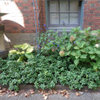History: New E.S. bought this spring from nursery in 5 gal pot. Started developing cerospora and showing chlorosis mid June, 4 weeks after planting. Really bad leaves were removed during the season and chelated iron was applied 2 weeks ago as plant showed very little signs of cerospora. Mulch was removed and replaced then as well. Since, we have had very intense thundershowers and the cerospora has become dramatically worse and chlorosis is following suit. The shrub appears healthy otherwise and of course didn't bloom. Oh, it is on drip irrigation.
If this happened earlier in the year I would be inclined to prune back infected areas and give the plant some N to promote growth. I have not had this happen this late in the season and don't want to the see the problem, especially the chlorosis, get worse before it goes into dormancy. Part of me tells me to just remove infected leaves and let it be but the little guy on my shoulder is telling me to prune hard and feed it. What would you be inclined to do?
Thanks for your opinion.
SCG








gardengal48 (PNW Z8/9)
SouthCountryGuy Zone 4b-5 SE BCOriginal Author
Related Professionals
West Milford Landscape Architects & Landscape Designers · Wheeling Landscape Architects & Landscape Designers · Willowick Landscape Architects & Landscape Designers · Salem Landscape Contractors · Stamford Landscape Contractors · Canton Landscape Contractors · Darien Landscape Contractors · Fairhope Landscape Contractors · Hawthorne Landscape Contractors · Mendota Heights Landscape Contractors · Overland Park Landscape Contractors · Waltham Landscape Contractors · Woodland Landscape Contractors · Boulder Siding & Exteriors · Kenosha Siding & Exteriorsluis_pr
SouthCountryGuy Zone 4b-5 SE BCOriginal Author
gardengal48 (PNW Z8/9)
SouthCountryGuy Zone 4b-5 SE BCOriginal Author